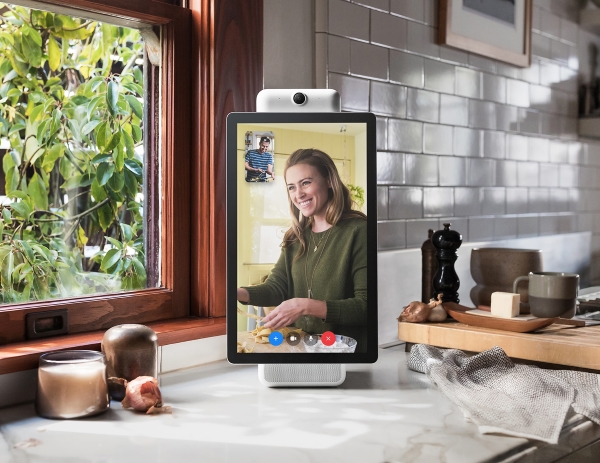[In addition to their features, most of the press coverage of Facebook’s new Portal devices emphasizes questions about the actual and perceived privacy the products will provide. This story is from Business Insider, where it includes other images. A 5:43 minute interview with Portal VP Rafa Camargo at Bloomberg includes the quote here about presence and several others including a specific reference to social and “video” presence. Wired has more details about the Portals including this:
“Get up and walk around, and the camera follows you, staying zoomed in. If there’s more than one human in the room, Portal will zoom out and recrop to fit everyone in the frame. If you want to zoom in on just one person, tap the screen and select ‘Spotlight mode,’ which locks Portal’s camera onto one face and body, keeping that person centered in the frame no matter who else comes and goes. The features are clever, and make the Portal feel miles more advanced than other dedicated videochat devices.”
At this writing the Portal website, portal.facebook.com, features a vivid image illustrating ‘connection’ between two users. –Matthew]

[Image: Source: Bloomberg]
Facebook wants to fix video calls with Portal, a $200 gadget that lets you talk to your Messenger friends
Rob Price
October 9, 2018
Facebook thinks video calls are broken — and it’s betting that people are willing to pay for a better experience.
On Monday, the Silicon Valley tech giant unveiled the Facebook Portal, a video-chat and smart-speaker device that it said would start shipping in November.
It’s a significant announcement for the company, one that puts it directly into competition with the likes of Google and Amazon and represents its first foray into building consumer hardware under the Facebook brand.
The Portal, which comes in two sizes, integrates with Facebook’s Messenger chat app and is designed to be used for video calls with a user’s friends.
The Portal will cost $199 and the larger Portal Plus $349, and it will be available only in the US. You can preorder it starting Monday.
The device also doubles as a voice-controlled home assistant and smart speaker in the vein of the Amazon Echo or Google Home. Facebook’s Portal comes with Amazon’s Alexa voice assistant built in, allowing it to respond to voice commands to carry out various tasks.
It’s an interesting time for Facebook to offer a product like this. The company has been rocked in recent months by a string of scandals — including a hack of about 50 million users’ accounts, announced late last month, and the Cambridge Analytica breach this spring — and its approach to user privacy is under intense scrutiny.
At a demonstration in San Francisco with Business Insider before the Portal’s launch, company representatives were quick to emphasize several privacy features of the device, from a camera cover to an outright ban on recording.
Better video calls
Facebook said it was launching the Portal to try to solve one of the big problems with video calls: They’re just not very good.
Often conducted on small smartphone screens, video calls are a pretty poor approximation of actual human connection.
“We designed them from the ground up to really address all the friction that exists today in video calls and get people from the feeling of being in a call to really feeling that they are together, that you’re in the same space, that you’re hanging out,” said Rafa Camargo, the vice president of Facebook Portal.
At rest, the Portal is basically a fancy digital photo frame, showing a preselected assortment of a user’s photos from their Facebook feed. Unless explicitly switched off, the camera and microphone default to always on, listening for commands and monitoring to see whether someone is in the room.
The user wakes it with a command, and it can call other Portal owners and people via Messenger.
It features a 140-degree wide-angle camera that can automatically track the user as they move around and crops the image around their face, meaning they aren’t stuck having to sit squarely in front of the screen. In testing, it was accurate, albeit not always as fast as the subject’s movements.
The screen on the larger Portal Plus is rotatable from landscape to portrait orientation, letting the user adapt it for one-on-one calls or chats with groups.
As a smart speaker, the Portal can do all the things you’d expect: play music, read the weather, and perform a variety of other tasks. Facebook has opted to use Amazon’s Alexa artificial-intelligence assistant for most non-call tasks, rather than build an in-house virtual assistant.
Smart speakers have exploded over the past few years, with the Amazon Echo leading the way. But it remains to be seen whether consumers will be willing to invite Facebook’s always-on microphones into their homes given the company’s history with user privacy.
Facebook representatives stressed the Portal’s privacy features, including a hardware button to deactivate the camera and microphone, a lens cap, and a decision by the company not to save any recordings.
Facebook also said there were no plans to display ads on the device.
So what about the hardware itself?
The Portal has a 10.1-inch screen with 720p resolution and weighs a little under 3 pounds. The Portal Plus, meanwhile, has a 15.6-inch screen with 1080p resolution and weighs 7.4 pounds. Both have 12-megapixel cameras.
Earlier reports said Facebook originally wanted to unveil the Portal at its F8 developer conference in May but shelved those plans amid the Cambridge Analytica scandal. Camargo, however, flatly denied that this was the case.
The device also has potential as an enterprise video-calling device in offices, though Facebook said it wouldn’t launch with any integration with Workplace, the business version of Facebook that the company sells to organizations.